Learn about the different types of black caterpillars with our extensive black caterpillar identification guide filled with pictures and fun facts.
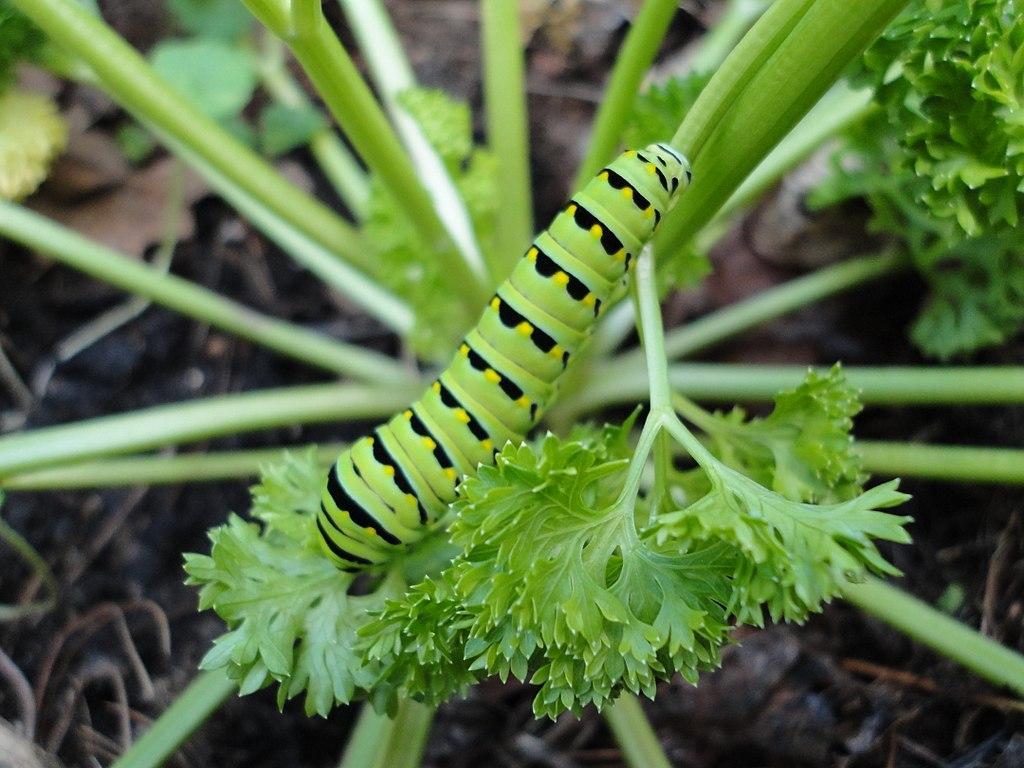
Despite what their names suggest, black swallowtail caterpillars are not entirely black
If you are here, you might be wondering, what kinds of caterpillars are black? Are they rare? Do they turn into moths or butterflies? Can they harm you? Whether or not they can cause severe damage to trees and plants! Our black caterpillar identification guide will help you find the answers to such and many more questions without the trouble of moving between multiple internet searches, all in one place!
There are many types of black caterpillars. Some of them are entirely black, while others have mixed colors. Some have a smooth body, while others have a furry or fuzzy look. Nonetheless, most black caterpillars are not very attractive creatures, even though some might turn into beautiful moths and butterflies later on. Also, they might look dangerous, but most of them are actually pretty harmless.
Then, there is the question of their hazardous nature towards plants, trees, and crops. To answer this, we will have to dig a bit deeper as it all comes down to the caterpillar species in question. But do not worry; our black caterpillar identification guide has got you covered. Happy reading!
Types Of Black Caterpillars
Identifying different caterpillar species involves carefully observing a number of characters. These might include noting the type of hairs or spines on a caterpillar’s body as well as what kinds of markings it has. Sometimes, you might also have to look for specific behavioral characteristics to correctly identify a caterpillar species, as some of them can look quite similar.
However, it is not rocket science either! All you need is a good identification guide, some pictures, and some outgoing friends with whom you can show your caterpillar identification skills. So, let’s dive right in!
1. Giant Leopard Moth Caterpillar
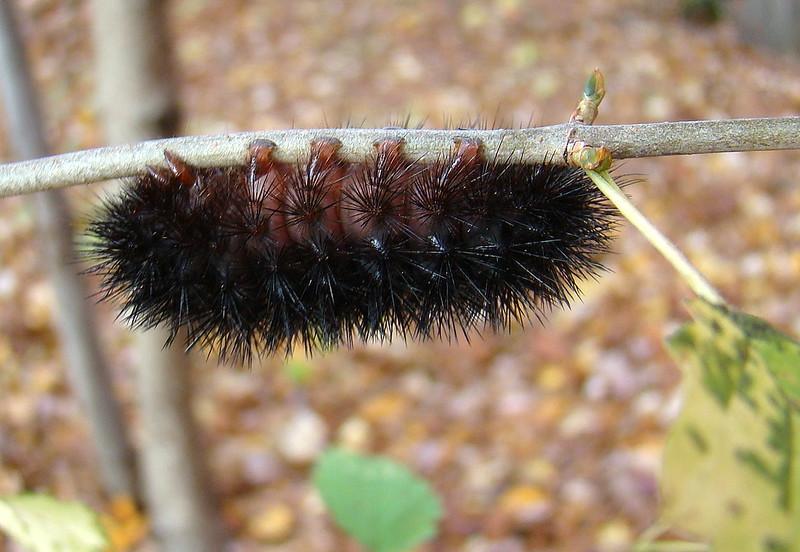
The giant woolly caterpillar rolls into a ball when threatened
Despite their menacing looks, giant leopard moth caterpillars are not something you should be afraid of. Their spines are not urticant, which means they do not break off when touched, causing irritation or discomfort. This giant leopard moth caterpillars are nocturnal and are therefore not generally seen during the daytime.
Being an unusual species of hairy caterpillars whose spines do not sting, it is okay to touch them lightly. Also, If you are lucky enough, the caterpillar might react by curling into a ball and let you see vibrant orange or red bands hidden among the thick cover of black spikes.
They overwinter as partly-grown larvae and do not form a cocoon until spring. They survive the cold, harsh winters by accumulating antifreeze compounds in their body. It keeps them safe from the harmful effects of freeze injury. These caterpillars are usually present in places like meadows, forest edges, farmlands, woodlands, and gardens.
Giant Leopard Moth Caterpillar Identification Guide And Quick Facts
| Scientific Name | Hypercompe scribonia |
| Other Names | Giant wooly bear caterpillar, Great leopard moth caterpillar |
| Size (Average) | Up to 7.5 cm in length |
| Color | Fuzzy black |
| Body Features | – Segmented body – Covered entirely with spindly black hairs – Red bands underneath the covering of thick black hairs |
| Hosts | – Polyphagous, feeding on numerous woody plants and low-growing forbs – Cabbage, lemon, sunflower, cherry, willow, dandelion, etc. |
| Distribution | – Distributed widely in North America – From southern Ontario to southern and eastern United States – Also present in New England, Mexico, and Panama. |
2. Garden Tiger Moth Caterpillar
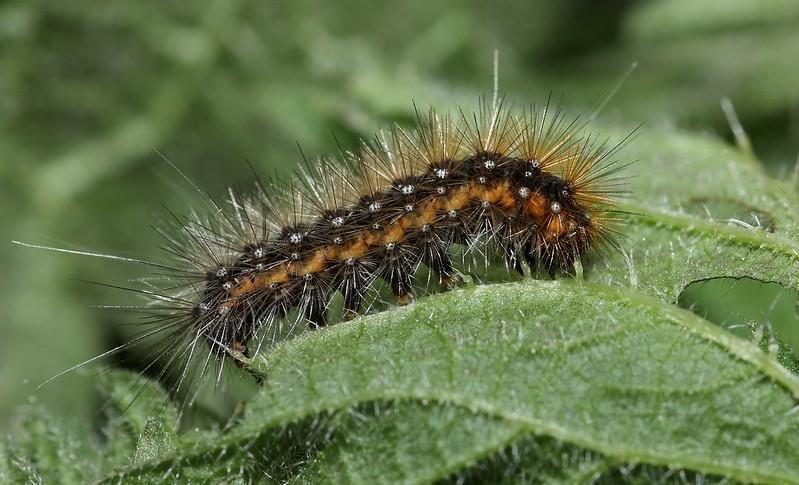
These fuzzy black caterpillars store bitter, toxic compounds in their bodies to deter predators
The garden tiger moth caterpillar is another woolly bear caterpillar on our list. They have a protective layer of stinging hairs on their bodies which acts as a deterrent to birds. In addition to that, these spiky tufts also provide some protection against parasitic wasps and flies. The garden tiger moth caterpillar does not sting, but the hairs on its body can still cause skin irritation.
The garden tiger moth caterpillar also has another defense mechanism up its sleeves besides tufts of yellow or orange spines. These black and orange caterpillars feed on plants like foxglove and daisies and store toxic compounds of the plants within their bodies. So now, even if some predator manages to cross the covering of orange spines, the caterpillar’s bitter taste deters them away.
Garden Tiger Moth Caterpillar Identification Guide And Quick Facts
| Scientific Name | Arctia caja |
| Other Names | Garden tiger woolly bears, Great tiger moth caterpillar |
| Size (Average) | 5 to 6 cm in length |
| Color | Black and orange |
| Body Features | – Long white hairs set amongst a thick layer of short black hairs – A line of tiny white spiracular dots on the back – There might also be some gray hair in addition to black and white hairs |
| Hosts | – A wide variety of herbaceous plants – Common Nettle, broad-leaved dock, water dock, burdocks, hound’s-tongue, etc. |
| Distribution | – Prefers habitats such as gardens, damp meadows, riverbanks, and open woodland – Found in the United States, Canada, and Europe |
3. Black Swallowtail Caterpillar
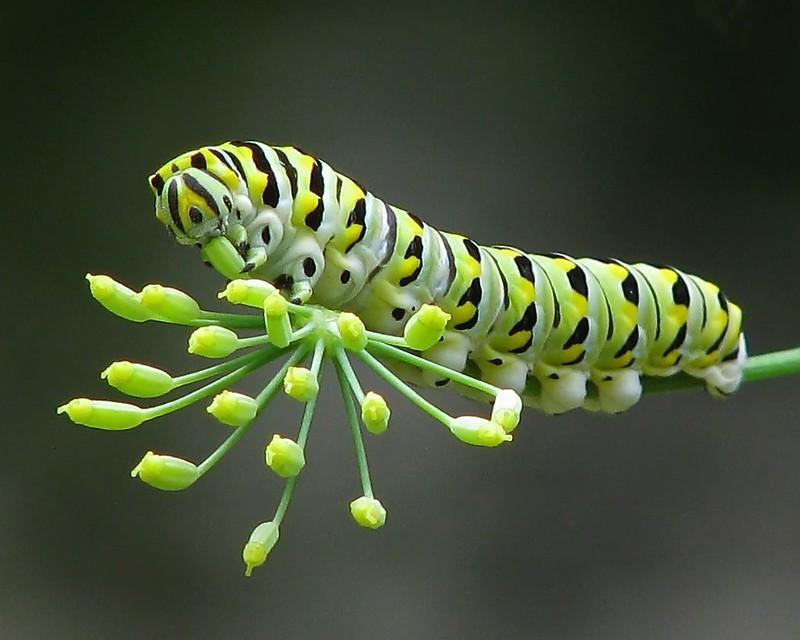
Also known as the Parsnip Swallowtail caterpillar, it has black or yellow stripes on its body
Black Swallowtail caterpillars have a yellow-orange colored eversible horn-like organ behind the head. It is called an osmeterium, and it looks like a forked snake tongue. The black swallowtail caterpillar uses it for defense. The organ releases a foul-smelling chemical to deter predators, which is harmless to humans.
Even though the black swallowtail caterpillar feeds on numerous cultivated plants, it rarely causes any significant damage to commercial agriculture. Also, it has many wasp and flea parasites as well as multiple insect predators that keep its population in check.
Black Swallowtail Caterpillar Identification Guide And Quick Facts
| Scientific Name | Papilio polyxenes |
| Other Names | American swallowtail caterpillar, Parsnip swallowtail caterpillar, Parsley worm |
| Size (Average) | Up to 5 cm in length |
| Color | Black and bright green |
| Body Features | – Black stripes on each body segment – Stripes contain raised yellow dots |
| Hosts | – Numerous herbs in the carrot family – Mock bishop’s weed, spotted water hemlock, poison hemlock, celery, parsley, etc. |
| Distribution | – Throughout southern Canada – Most of the eastern and mid-western United States – Northern Mexico |
4. Pipevine Swallowtail Caterpillar

A black spiny caterpillar characterized by rows of orange markings on the back
The next black spiky caterpillar on our list is the Pipevine swallowtail caterpillar. This dark-colored caterpillar is named so because it only feeds on specific plants known as pipevine plants. Like the American swallowtail caterpillar, it also has osmeterium, a defensive organ that looks like a forked snake tongue.
The caterpillar also stores the toxic compounds of pipevine plants in its body as it feeds. These bitter, toxic compounds make them unpalatable to predators. Pipevine caterpillars tend to feed in groups when they are young but become solitary as they grow old.
Pipevine Swallowtail Caterpillar Identification Guide And Quick Facts
| Scientific Name | Battus philenor |
| Other Names | Blue swallowtail caterpillar |
| Size (Average) | Up to 5 cm in length |
| Color | – When young, the caterpillar is dark red – Dark black during the final larval stage |
| Body Features | – Long black tubercles on the front of their heads – Short orange tentacles extended over the length of the body |
| Hosts | Genus Aristolochia, commonly known as pipevine plants |
| Distribution | – Southeastern Canada, Southern Mexico – In the United States, pipevine caterpillars are found in Connecticut, Arizona, and Florida |
5. Scarce Dagger Moth Caterpillar
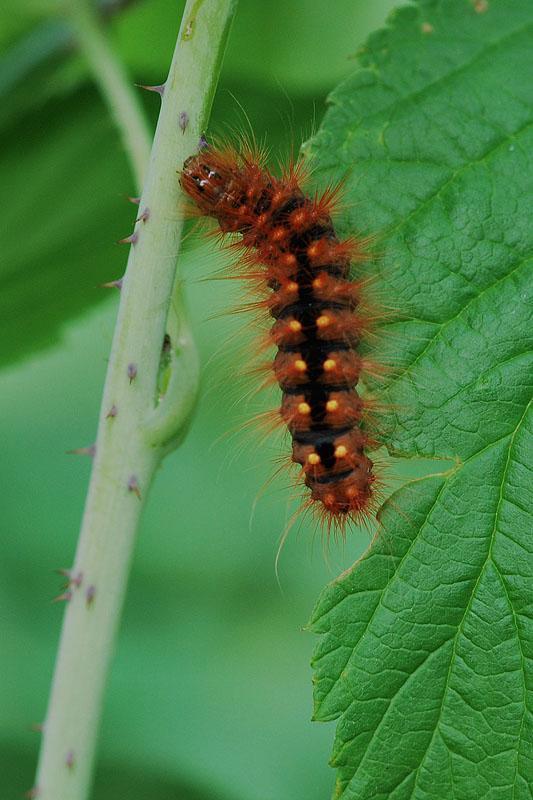
A scarce dagger moth caterpillar has distinct yellow and white markings on its body
These fuzzy black caterpillars have numerous extremely sharp hairs or setae on their body. Even though these hairs are not venomous, they can still cause severe skin irritation, if touched. These black fuzzy caterpillars get the word “dagger” in their name from the dagger-like markings found on adult moths’ bodies.
Scarce dagger moth caterpillars prefer to live in grassland edges, drier clearings in woodlands, or dry forest fringes. These black fuzzy caterpillars are not considered a serious pest to the plants that they feed on. The caterpillar species displays colors of yellow on black, which are characteristic of wasps and bees. This makes their predators think twice before attacking.
Scarce Dagger Moth Caterpillar Identification Guide And Quick Facts
| Scientific Name | Acronicta auricoma |
| Other Names | Scarce dagger caterpillar |
| Size (Average) | Nearly 4 to 5 cm in length, when fully grown |
| Color | Dark black |
| Body Features | – Tufts of black and orange/red setae – Distinct yellow and white dots on the back – Clumps of sharp hairs on each segment arising from the dots mentioned above |
| Hosts | Predominantly oak, rubus, calluna, and vaccinium |
| Distribution | – Throughout most of the Palearctic region |
6. Peacock Butterfly Caterpillar
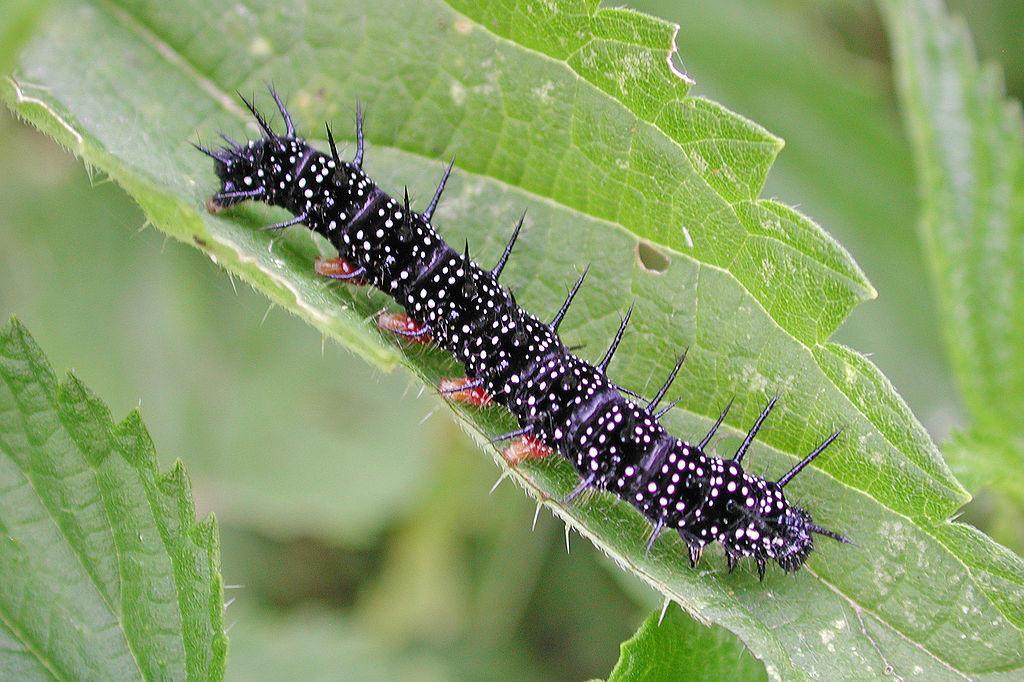
The Peacock butterfly caterpillar has a striking black body covered with white dots
This black caterpillar is known for its voracious appetite. It can feed on flowers, leaves, fruits, twigs, roots, and even small insects. The caterpillar usually spends its time in leaf crowns, but as they grow, they start spending their time increasingly in the open. The caterpillars, when young, resemble bird droppings which saves them from predators.
The best time to see these caterpillars is between May and July, when they can be found feeding on stinging nettle plants. The larva gives rise to one of the most remarkable butterfly species on earth, the peacock butterfly. The butterfly has bright showy colors when compared to the plain black caterpillar. The butterfly feeds on the nectar of the same plants on which its larval stages, i.e., caterpillars live.
Peacock Butterfly Caterpillar Identification Guide And Quick Facts
| Scientific Name | Aglais io |
| Other Names | European peacock butterfly caterpillar |
| Size (Average) | Up to 4 cm in length |
| Color | Dark black |
| Body Features | – A black segmented body with a round black head – Body is covered with numerous white dots – Soft black bristles arising from each body segment – Fleshy pink legs |
| Hosts | Small nettle, stinging nettle, and hop |
| Distribution | Europe and temperate areas of Asia |
7. Walnut Caterpillar
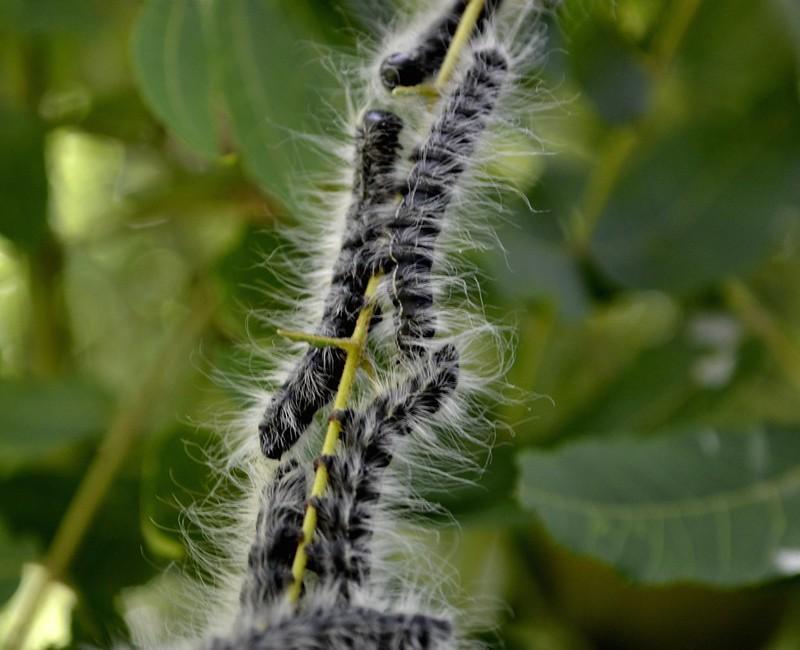
These fuzzy caterpillars have a lot of silver-gray hair spread all over their bodies
These walnut caterpillars are hungry creatures. Damage caused by young caterpillars is primarily localized to a few branches where young caterpillars feed in groups. However, large mature walnut caterpillars can defoliate entire trees, severely affecting the yield. Walnut caterpillars are also called the “Processionary Caterpillars” due to their habit of living in communal webs and marching to the food source in columns.
There have been occasional outbreaks leading to economic loss, but the caterpillar rarely attains significant numbers to cause a financial loss. As the name suggests, the walnut caterpillar loves walnut leaves, and after collecting enough energy, it falls to the ground in search of a secure place to pupate.
Walnut Caterpillar Identification Guide And Quick Facts
| Scientific Name | Datana integerrima |
| Other Names | Processionary caterpillars |
| Size (Average) | Up to 5 cm in length |
| Color | – Dark brown or red when young – Dark gray or black when fully mature |
| Body Features | – Extremely find gray hair spread all over the body – Thickly furred body |
| Hosts | – A wide variety of deciduous trees – Mostly butternut, hickory, pecan, and walnut |
| Distribution | – Native to North America – Common throughout most of the eastern United States |
8. Azalea Caterpillar
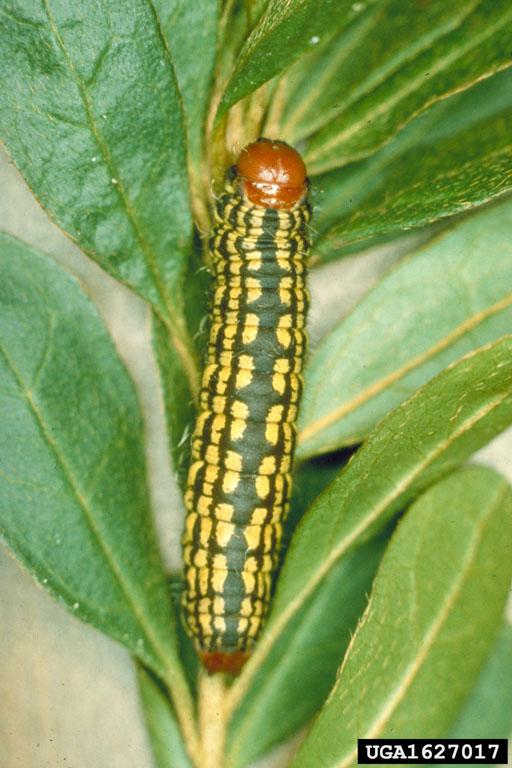
An azalea caterpillar can be easily recognized by its orange head and a black-yellow body
As its name suggests, the azalea caterpillar is very fond of the azalea plants. The caterpillar is very active between July and October. It often defoliates much of the shrub before they are even detected. Despite being the hairy kind, the caterpillar is harmless to humans. You can even pick it up in your hand without any worries.
Although, when threatened, these black and yellow caterpillars raise their bodies and make a C-shape. Azaria caterpillars are gregarious creatures, and controlling their populations is relatively easy. It is best to prevent their infestation as soon as possible because they can defoliate entire plants overnight.
RELATED: Furry Caterpillar Types with An Identification Guide, Fun Facts, and Pictures
Azalea Caterpillar Identification Guide And Quick Facts
| Scientific Name | Datana major |
| Other Names | Labor Day worms |
| Size (Average) | 1 to 1.5 cm in length |
| Color | Black and yellow |
| Body Features | – A globular red or orange head – Yellow stripes or markings on the body – Body is relatively smooth |
| Hosts | – Largely, azalea plants – Sometimes, blueberry, red oak, andromeda and apple |
| Distribution | Maryland, Florida, Kansas, and Arkansas |
9. Woolly Bear Caterpillar
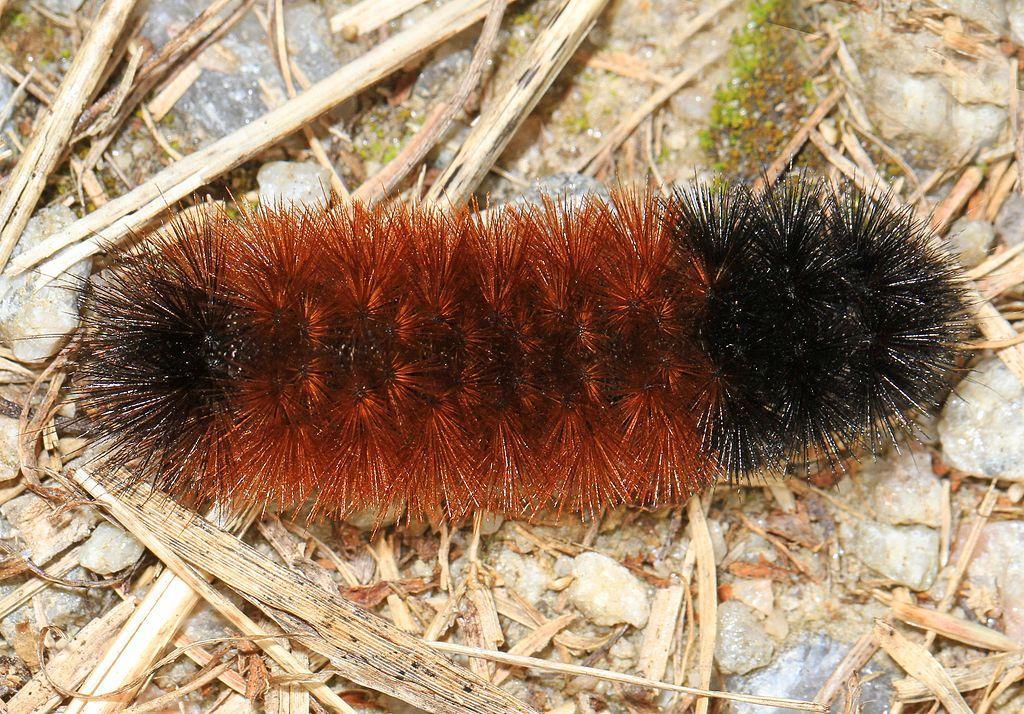
The woolly bear caterpillar is also known as the Isabella tiger moth caterpillar
The woolly bear caterpillar is a familiar sight for many in late summer and early fall. It gets its name from its extremely furry look because of its thick covering of black and brown hairs. The black hairs cover the endings, whereas a patch of brown hair is present between them.
These woolly caterpillars curl into a ball and play dead when threatened. According to folklore, the amount of black hair on woolly bear caterpillars in autumn can predict the severity of the coming winter. Its stiff hairs act as a deterrent for predators and any unlucky curious humans who dare to touch it! The woolly bear caterpillar is also known as the Isabella tiger moth caterpillar.
Woolly Bear Caterpillar Identification Guide And Quick Facts
| Scientific Name | Pyrrharctia isabella |
| Other Names | Woolly worm, Banded woolly bear, Hedgehog caterpillar |
| Size (Average) | Up to 6 cm in length |
| Color | Black-brown caterpillars |
| Body Features | – A thick brown or orange band of hairs in the middle of thick black hairs on the side |
| Hosts | – Generalists, consuming many herbs and plants – Commonly, dandelion, dock, aster, goldenrod, birches, clover, corn, and sunflower |
| Distribution | Southern Canada and the United States |
10. Tersa Sphinx Caterpillar
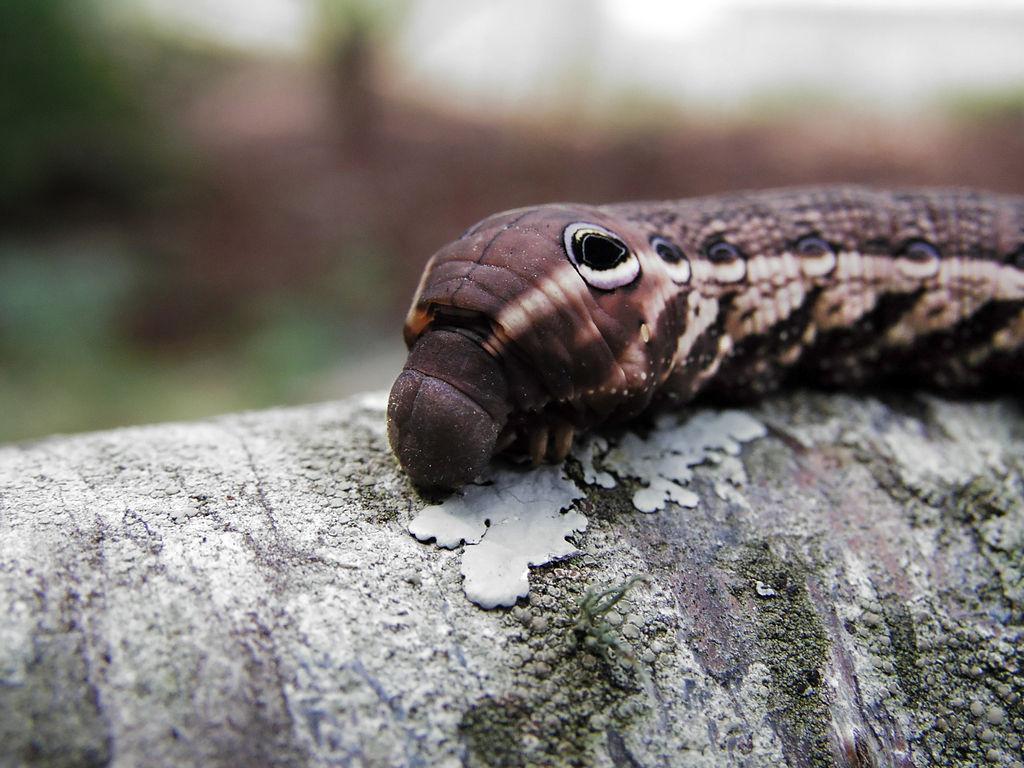
A tersa sphinx moth caterpillar has eye-like markings on its body
You will not confuse this caterpillar with any other because of its unusual look. The caterpillar has numerous eye-like markings on its back. It is because the tersa sphinx caterpillar is a snake-mimic which helps it to avoid predators. They get the word “sphinx” in their name because of their habit of resting in position with the front of the body raised up.
These caterpillars are also sometimes aptly called hornworms. It is because they have a horn-like protrusion at the back end of their body, which they use for defense and to move around. Mature larvae bury themselves within the leaf litter, where they spin a cocoon and get ready for pupation.
Tersa Sphinx Caterpillar Identification Guide And Quick Facts
| Scientific Name | Xylophanes tersa |
| Other Names | Tersa hornworm caterpillar |
| Size (Average) | Up to 8 cm in length |
| Color | Pale green to brown or dark brown |
| Body Features | – Eye-like markings on the body – A horn-like protrusion emerging from the back end |
| Hosts | – Numerous flowering plants – Examples: False buttonweed, catalpa, firebush, shrubby yellow crest, wild coffee |
| Distribution | United States, Mexico, West Indies, Central America, parts of South America, and some areas of Canada |
11. White-Lined Sphinx Caterpillar
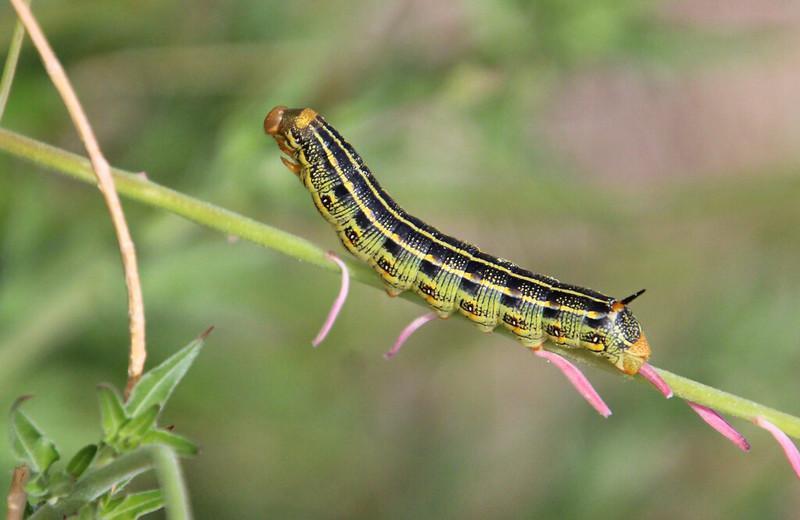
A white-lined sphinx caterpillar is also called the hummingbird moth caterpillar because of its size
The white-lined sphinx moth caterpillar is also quite variable in color, just like the tersa sphinx moth caterpillar. Also, it has a horn at one end of its body and is called a sphinx caterpillar for the same reasons as the tersa sphinx moth caterpillar. The caterpillar was once used as food by the native American people.
These caterpillars are often seen during late summer or early fall. These days, they often migrate to the ground to find a safe place to spin a cocoon. The caterpillar is not harmful, and you can handle it with care. However, these caterpillars are vicious eaters, and they can form massive groupings which can destroy whole crops within a matter of days.
White-Lined Sphinx Caterpillar Identification Guide And Quick Facts
| Scientific Name | Hyles lineata |
| Other Names | Hummingbird moth caterpillar (because of their size) |
| Size (Average) | Up to 9 cm in length |
| Color | – Quite variable in color- Some are Black with orange spots- Others are green with red spots |
| Body Features | – A orange or yellow horn-like protrusion with a black tip on one end of the body- Clusters of white/yellow dots spread all over the body |
| Hosts | Apple, evening primrose, four-o’clock, fuchsia, tomato, grape, elm, and willow weed |
| Distribution | Spread throughout central and north America |
12. Catalpa Sphinx Moth Caterpillar
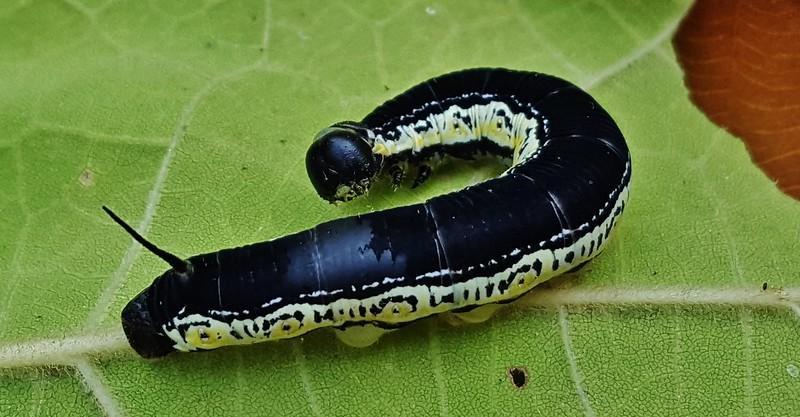
A catalpa caterpillar is very popular as fish bait among the fishermen of North America
As its name suggests, the Catalpa Sphinx Moth caterpillar feeds exclusively on catalpa trees. Sometimes they can gather in huge numbers on catalpa trees and completely defoliate them, but such instances are not common. Due to their abundance, they are very popular as fish bait among the fishers of southeastern North America.
They are most abundant between May and November. They are the only sphinx moth caterpillars that feed gregariously through the third and fourth molts (molting is a process in which a caterpillar sheds its old skin). Like other sphinx moth caterpillars, catalpa caterpillars also possess a stiff horn near one end of the abdomen.
Catalpa Sphinx Moth Caterpillar Identification Guide And Quick Facts
| Scientific Name | Ceratomia catalpae |
| Other Names | Catalpa worm, Catawba worm |
| Size (Average) | Up to 5 cm in length |
| Color | – Young caterpillars are primarily black with white dots – Older caterpillars are black with yellow lines or markings on the body |
| Body Features | – A horn-like protrusion on one side of the abdomen – Shiny black bodies, when fully matured |
| Hosts | Mostly, northern and southern catalpa trees – Sometimes, Chinese catalpa trees |
| Distribution | – Native to the eastern United States – Historically found in New England but now absent |
RELATED: What Do Caterpillars Eat? Top 3 Host Plants You Must Know!
13. Mourning Cloak Caterpillar

The caterpillar gives rise to the mourning cloak butterfly, which is the state insect of Montana USA
The word “mourning” in their names comes from the color of the butterfly’s underside, a very dull shade of brown-gray. They are gregarious throughout their lives, meaning they live and feed in large social groupings. When threatened, all the caterpillars in a group start twitching in unison in order to deter the threat.
These caterpillars are also sometimes called Spiny elm caterpillars, but elm is only one of the host plants they feed on.
These caterpillars are also known to eat the unhatched eggs as soon as they emerge. It is believed that caterpillars do that to reduce competition.
Mourning Cloak Caterpillar Identification Guide And Quick Facts
| Scientific Name | Nymphalis antiopa |
| Other Names | Spiny elm caterpillar, Camberwell beauty caterpillar |
| Size (Average) | 5 to 6 cm in length |
| Color | Dark gray or black |
| Body Features | – Red or orange markings on each segment – Whole body is covered with tiny white specks – Several rows of black bristles |
| Hosts | Willow, birch, elm, cottonwood, and hackberry |
| Distribution | – Widely distributed across the northern hemisphere – Commonly found in North America and northern Eurasia |
14. Black Cutworm Moth Caterpillar

A black cutworm caterpillar has an unusual habit of cutting down the stems of newly hatched plants rather than their leaves
These caterpillars are called cutworms because of their habit of attacking the newly emerged plants at ground level. Rather than climbing up the plant and feeding on leaves, they eat their way through the bottom stem and literally cut down the plant. Black cutworms are especially an issue for home gardeners and fresh market growers.
While this caterpillar can become a severe pest, it is sporadic with large outbreaks being relatively uncommon. Nonetheless, care should be taken as losses can be severe if the caterpillar infests the crop at the right time.
Black Cutworm Moth Caterpillar Identification Guide And Quick Facts
| Scientific Name | Agrotis ipsilon |
| Other Names | Ipsilon dart caterpillar, floodplain cutworm, greasy cutworm, dark-sword grass caterpillar |
| Size (Average) | 2 to 5 cm in length |
| Color | Brown or gray-black |
| Body Features | – A fat and smooth shiny body – Body is covered in tiny black freckles |
| Hosts | – Wide range of ornamental, garden, and turf plants as well as field crops – Chickweed, curly dock, mustard, yellow rocket, blue grass, clover, cotton, rice, etc. |
| Distribution | – Distributed worldwide – More common in the northern hemisphere |
15. Great Spangled Fritillary Caterpillar
The great spangled fritillary caterpillar is a timid and secretive creature. It is nocturnal, which means it is active at night. It spends its days hiding below in the leaf litter to avoid the hungry birds that might be looking for a juicy meal. If disturbed, the Great spangled fritillary caterpillar releases a foul-smelling odor from rounded glands on the sides of their heads.
One interesting fact about these caterpillars is the fact that the newly hatched larvae do not eat. Instead, they overwinter till spring and then start feeding on violet plants. The Great spangled fritillary caterpillar prefers to live in open, moist places, including fields, pastures, meadows, open woodlands, and prairies.
Great Spangled Fritillary Caterpillar Identification Guide And Quick Facts
| Scientific Name | Speyeria cybele |
| Other Names | – |
| Size (Average) | Up to 4 or 5 cm in length |
| Color | Jet Black |
| Body Features | – Rows of black spines all over the body – Spines have yellow or orange tips – Bulb-shaped glands located on the head |
| Hosts | Various species of Violet |
| Distribution | Central California and Northern Georgia, as well as from southern British Columbia to the Canadian Maritimes |
16. Red Admiral Caterpillar
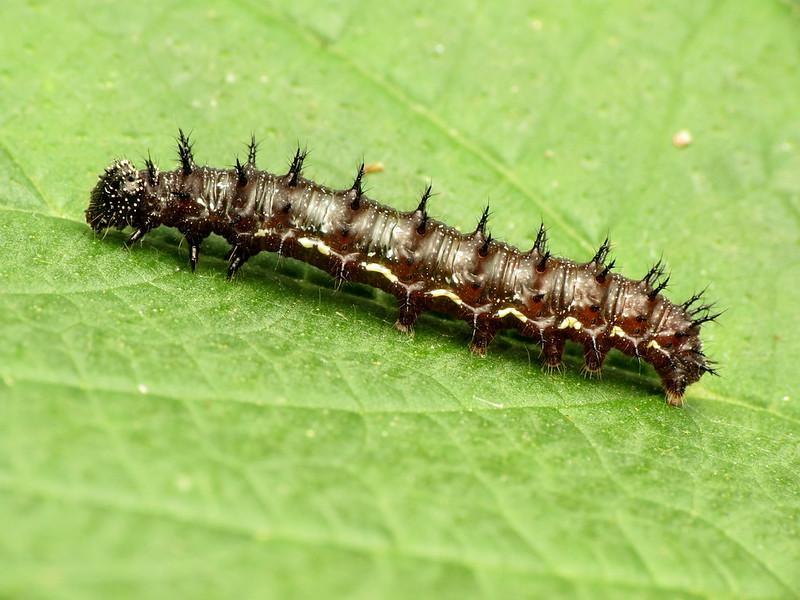
A red admiral caterpillar is jet black with yellow specks spread all over its body
These caterpillars can be found in moist woodlands. The caterpillars feed on numerous plants, but its primary host is the stinging nettle. Unlike most caterpillars, these red admiral caterpillars make several shelters throughout their life. Also, the young caterpillars tend to live together in a nest made up of folded leaves, while the older caterpillars are primarily solitary.
The caterpillars only come out of these tent-like nests to feed. They can easily be located on plants if you have an eye for finding these tent-like nests made up of folded leaves. The caterpillar usually resides in the largest of the tents.
RELATED: Types of Green Caterpillars with Fun Facts, Stunning Pictures and Loads More!!!
Red Admiral Caterpillar Identification Guide And Quick Facts
| Scientific Name | Vanessa atalanta |
| Other Names | Red admirable tent caterpillar |
| Size (Average) | Around 2.5 cm in length |
| Color | – Variable in color – Usually yellow or black |
| Body Features | – Black caterpillars are covered with numerous yellow markings – Yellow markings often create a line on the sides of the body – Tufts of black spines arising from each body segment |
| Hosts | – Most commonly, stinging nettle – Caterpillar also feed on false nettle, heartleaf nettle, and burning nettle |
| Distribution | Europe, northern Africa, Eurasia, Canada, and Central America |
Frequently Asked Questions
Are Black Caterpillars Poisonous?
Most of the black caterpillars are not poisonous, venomous, or as a matter of fact, harmful at all. However, it does not mean that you can go around picking up these creeping crawling creatures. Especially, you might want to stay away from the black fuzzy ones.
Some of these fuzzy black caterpillars might have sharp spines or stinging hairs that can give you a nasty rash or severe irritation on the touch. Also, some of these spines can break apart from the caterpillar’s body and pierce your skin. Sometimes these spines are also connected with venom glands underneath, which can cause health problems for sensitive individuals.
What Does The Black Caterpillar Turn Into?
It all comes down to the type of species you are talking about. Some of these caterpillars turn into moths, while others turn into butterflies. Usually, the hairy or fuzzy ones turn into moths, while the smooth ones generally turn into butterflies.
You can look at this guide to find out more about the type of caterpillars that turn into moths and butterflies.
What Kind Of Caterpillar Is Black And Fuzzy?
Fuzzy caterpillars come in various colors ranging from white to complete black. They are also called furry or hairy black caterpillars. You can look at this article to learn more about these fascinating creatures.
As far as black fuzzy caterpillars are concerned, there are many species. Examples include giant leopard moth caterpillar, garden tiger caterpillar, and woolly bear caterpillar.
Are Black Caterpillars Poisonous To Dogs?
According to the National Canine Research Association of America, caterpillars are not something you need to worry about when it comes to your pets, especially dogs. However, it also does not mean that you should let your pets put them in their mouth.
Especially, you need to be aware of the furry or fuzzy kind. These hairy caterpillars can have spines that can give nasty wounds on touch. Also, some of these caterpillars feed on toxic plants and store the toxic compounds as a defense in their bodies. Ingesting these chemicals can cause nausea or other gastrointestinal problems in dogs.
How Do You Get Rid Of Black Fuzzy Caterpillars?
You can try scraping eggs and overwintering caterpillars out of their cocoons with your hand before they start eating. In addition to that, there are multiple organic and synthetic compounds available in the market that you can spray in your garden or on plants near your home to get rid of black caterpillars.
In case of an infestation, it is always better to seek professional help or expert guidance.
Sources For Further Reading
- Fuzzy fall visitors: Caterpillars that attract attention and could cause needless concern. (2020). Retrieved 26 March 2022, from https://www.canr.msu.edu/news/fuzzy_fall_visitors_caterpillars_that_attract_attention_and_could_cause_nee
- Stinging Caterpillars | Entomology. (2022). Retrieved 26 March 2022, from https://entomology.ca.uky.edu/ef003
- Caterpillars on ornamental plants. (2022). Retrieved 26 March 2022, from https://extension.umn.edu/yard-and-garden-insects/caterpillars-ornamental-plants
Now that you know more about black caterpillar read our other articles to discover more plant bugs:
Root Maggots: How to Get Rid of Root Eating Insect Pest Naturally?
Identification and Control of Darkling Beetles by Natural and Chemical Ways







